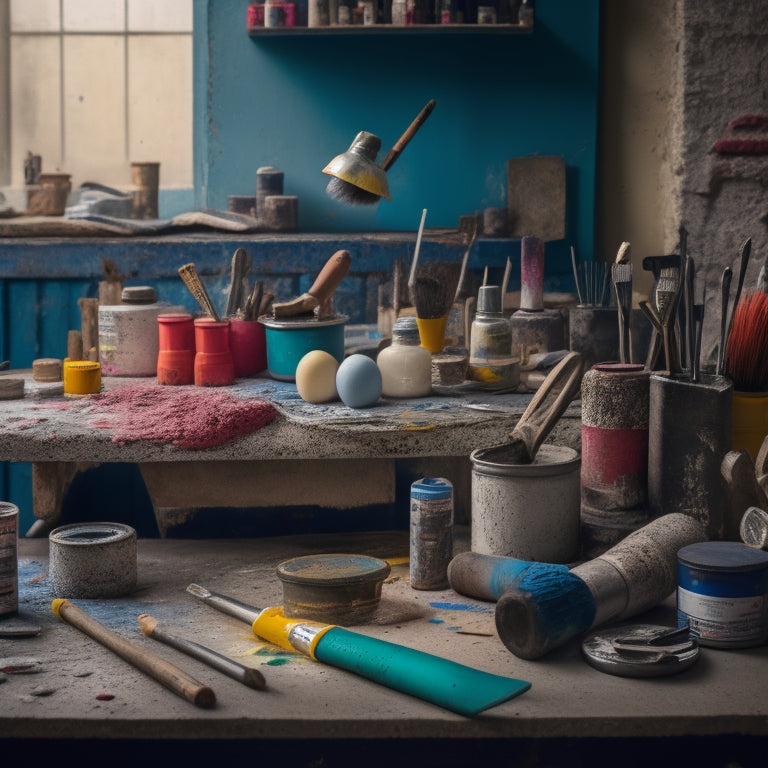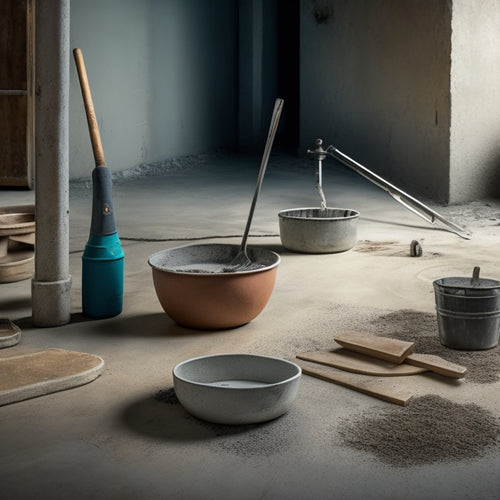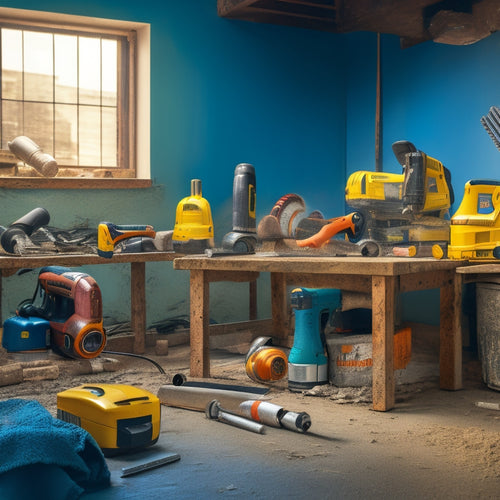
What Tools to Buy for Concrete Painting
Share
When painting concrete, you'll need a range of tools to achieve a professional-looking finish. Start with high-quality brushes, specifically designed for rough, porous surfaces, and select the right roller type for your chosen paint finish. Don't forget paint sprayers, which are ideal for large surfaces or detail work. Surface preparation is key, so invest in cleaning tools, such as pressure washers and scrapers, as well as grinding tools to create a rough texture for better paint bonding. Add specialized edging tools, protective gear, measuring and marking tools, and cleaning and maintenance essentials to your arsenal, and you'll be well-equipped to tackle your concrete painting project - and with the right techniques and strategies, you can take your results to the next level.
Key Takeaways
• Invest in high-quality painting tools like brushes, rollers, and sprayers specifically designed for concrete painting.
• Prepare the surface with cleaning tools like pressure washers and scrapers, and grinding tools like diamond grinders for a strong paint bond.
• Use specialized edging tools for creating crisp, clean edges and advanced edge design techniques.
• Protect yourself with safety gear like goggles, respirators, gloves, and coveralls to shield from spills and chemicals.
• Measure and mark accurately with tools like laser distance meters, digital calipers, and marking tools to achieve professional-looking finishes.
Essential Concrete Painting Brushes
When painting concrete, you'll need a range of high-quality brushes specifically designed to tackle the porous, rough surface of concrete. Natural bristle brushes are ideal for applying thick, textured coatings, while synthetic brushes work better with thinner, water-based paints.
You'll also need angular-cut brushes for cutting in around edges and corners, and flat, broad brushes for covering large areas.
Moreover, you'll want to take into account the brush's nap length, which affects the finish. Longer naps create a more textured finish, while shorter naps produce a smoother one. Additionally, you'll need to choose the right brush size for your project. Larger brushes cover more surface area, but smaller ones provide more precision.
In terms of painting techniques, you'll want to use a combination of sweeping strokes and gentle pressure to work the paint into the concrete's pores. This guarantees a strong bond between the paint and the surface.
Best Rollers for Smooth Finish
By investing in the right roller, you can achieve a smooth, even finish on your concrete surface, which is especially important when working with low-sheen or high-gloss paints.
When it comes to roller types, you have two main options: microfiber and foam. Microfiber rollers are ideal for applying thin, even coats and are perfect for epoxy or polyurethane-based paints. Foam rollers, on the other hand, are better suited for thicker, textured coatings and are often used with acrylic or latex-based paints.
To achieve a smooth finish, you'll want to use a roller with the right nap length. A shorter nap length (1/4 inch or less) is best for smooth, low-sheen finishes, while a longer nap length (1/2 inch or more) is better suited for textured, high-gloss finishes.
You'll also want to take into account the roller's core material and handle type. Look for rollers with durable, rust-resistant cores and comfortable, ergonomic handles that make it easy to work for extended periods.
Concrete Surface Preparation Tools
When preparing a concrete surface for painting, you'll need to tackle three critical steps:
cleaning the surface,
removing old coatings,
and grinding the concrete.
You'll want to start by ensuring the surface is free of dirt, oil, and other substances that might interfere with paint adhesion.
Clean the Surface
You'll need to gather essential concrete surface preparation tools to thoroughly remove dirt, grime, and old coatings from the concrete surface. This step is vital to guarantee a strong bond between the concrete and the paint. A clean surface also allows you to assess the surface texture, which can affect the paint's adhesion and appearance.
To clean the surface, you'll need the following tools:
| Tool | Description | Purpose |
|---|---|---|
| Pressure Washer | A high-pressure water sprayer | Remove dirt, grime, and loose debris |
| Cleaning Solutions | Chemicals or detergents specifically designed for concrete | Dissolve and remove grease, oil, and other stains |
| Broom or Scraper | A sturdy brush or scraper | Remove loose debris and scrub the surface |
When using these tools, make sure to follow the manufacturer's instructions and take necessary safety precautions, such as wearing protective gear and working in a well-ventilated area. By properly cleaning the surface, you'll create a solid foundation for a successful painting project.
Remove Old Coatings
Frequently, old coatings, such as paint, sealers, or wax, must be stripped away to guarantee a strong bond between the concrete and new paint.
You'll need to assess the surface to determine the best coating removal techniques for your project. Start by inspecting the surface for any signs of damage, such as cracks, flaking, or peeling. This surface damage assessment will help you decide which removal method to use.
For solvent-based coatings, you may need to use a chemical stripper, while water-based coatings can be removed with a pressure washer. In some cases, you may need to use a combination of both methods. Always follow the manufacturer's instructions and take necessary safety precautions when working with chemicals.
Once you've removed the old coating, inspect the surface again to verify it's clean and free of residue. This will confirm a strong bond between the concrete and your new paint job, giving you the freedom to create a beautiful, long-lasting finish.
Grind the Concrete
Grind the concrete surface to create a rough texture, allowing the new paint to bond firmly and evenly. This step is essential for a successful concrete painting project.
You'll need to remove any existing sealers, old paint, or dirt that may be preventing the new paint from adhering properly.
When it comes to grinding, you have a few options. You can use concrete grinding techniques with a walk-behind grinder or a handheld grinder, depending on the size of your project. Diamond grinding tools are ideal for this task, as they effectively remove old coatings and roughen the surface without damaging the concrete.
Be certain to choose the right grit level for your grinder, as this will determine the level of roughness you achieve. Remember to work in small sections, overlapping your passes to guarantee an even finish.
As you grind, be sure to vacuum up any debris to prevent it from getting in the way of your new paint job. With a properly prepared surface, you'll be ready to move on to the next step: applying your new paint.
High-Quality Paint Sprayers Needed
Selecting a high-quality paint sprayer is essential for achieving a smooth, even finish on your concrete surface.
You'll want to choose a sprayer that suits your specific needs, considering factors like coverage area, pressure control, and nozzle type. There are two primary paint sprayer types: airless and HVLP (high-volume, low-pressure). Airless sprayers are ideal for large, smooth surfaces, while HVLP sprayers are better suited for detail work and fine finishes.
When it comes to spray technique, you'll want to master a few key tips. Hold the sprayer 8-10 inches from the surface, moving in steady, parallel passes to maintain even coverage. Apply thin, consistent coats, allowing each layer to dry before adding the next.
Avoid spraying in circular motions, which can create unevenness and texture. By selecting the right sprayer and honing your spray technique, you'll be well on your way to achieving a professional-looking finish on your concrete surface.
Specialized Concrete Edging Tools
When painting concrete, mastering the art of creating crisp, clean edges is essential. Specialized concrete edging tools come into play, enabling you to achieve sharp, defined lines that elevate your overall finish.
These tools are designed to help you execute advanced edge design techniques, such as sharp angles, curves, and intricate patterns. With the right edging tools, you'll be able to create clean, precise lines that add a professional touch to your concrete painting project.
When selecting concrete edging tools, consider the material choices. Stainless steel or high-carbon steel tools are ideal for concrete painting, as they provide durability and resistance to corrosion.
You may also opt for tools with ergonomic handles, which reduce fatigue and improve control. Additionally, look for tools with adjustable angles, allowing you to customize your edge design to fit your specific needs.
Protective Gear for Painters
You'll need to shield yourself from paint spills, stains, and harsh chemicals by donning the right protective gear, which is vital for ensuring a safe and healthy painting experience. As a painter, you're exposed to various hazards that can compromise your health and well-being. That's why it's important to adhere to safety standards and invest in quality protective gear.
Start with a good pair of gloves that provide grip, dexterity, and protection from chemicals. Look for ones with a waterproof coating and breathable materials to prevent moisture buildup.
Safety glasses or goggles are also a must-have to protect your eyes from paint splatters and debris. A dust mask or respirator will help you breathe easily while working with harsh chemicals or in dusty environments.
Don't forget to wear long-sleeved shirts, pants, and closed-toe shoes to prevent skin exposure. A painter's hat or hood can also protect your hair and scalp from paint stains.
Measuring and Marking Tools
When you're preparing to paint a concrete surface, you'll need to make certain you have the right measuring and marking tools to get the job done accurately.
You'll be using these tools to take precise measurements, mark straight lines, and create stencil guides for your design.
Accurate Measurement Devices
Measure precise dimensions and angles with accurate measurement devices, a crucial step in concrete painting that guarantees a professional-looking finish.
When it comes to concrete painting, you can't afford to make mistakes in measurements, as it can lead to uneven patterns, wastage of materials, and a subpar finish.
To guarantee precision, invest in the following accurate measurement devices:
-
Laser distance meters: These digital measuring tools provide accurate distance and angle measurements, making it easy to calculate complex calculations.
-
Digital calipers: Perfect for measuring small dimensions, digital calipers offer precise readings with a high degree of accuracy.
-
Angle finders: These handy tools enable you to measure angles with ease, ensuring your designs are symmetrical and balanced.
- Measuring tapes with fractional readings: These tapes provide precise measurements in fractions of an inch, allowing you to achieve accurate layouts.
Marking Straight Lines
With accurate measurements in hand, create sharp, precise lines using specialized marking tools that help you achieve professional-looking results in your concrete painting project.
To guarantee crisp, clean lines, you'll need a reliable method for applying tape. Invest in a high-quality tape applicator, which allows for smooth, even tape application. This tool helps prevent bubbles, wrinkles, and uneven edges, giving you a precise edge for your paint.
For more intricate designs or complex patterns, line guides are essential. These tools enable you to create precise, straight lines or curved paths, guaranteeing your design is accurately transferred to the concrete surface. Look for line guides with adjustable angles and lengths to accommodate various design requirements.
Creating Stencil Guides
To guarantee accurate stencil placement and precise pattern repetition, you'll need to create stencil guides using specialized measuring and marking tools.
These guides will help you achieve professional-looking results, making certain your design is transferred flawlessly onto the concrete surface.
To create stencil guides, you'll need the following tools:
-
Laser level: Projects a precise level line onto the concrete, allowing you to create perfectly straight stencil guides.
-
Chalk line reel: Creates temporary lines on the concrete, helping you mark out complex designs and patterns.
-
Measuring tape: Assures accurate measurements and spacing between stencil guides, preventing errors and inconsistencies.
- Stencil material: Provides a stable, durable surface for your stencil design, allowing for crisp, clean lines and patterns.
Cleaning and Maintenance Essentials
You'll need a few essential cleaning and maintenance tools to keep your concrete painting project looking its best over time. Investing in the right cleaning solutions and maintenance techniques will guarantee your artwork remains vibrant and protected from the elements.
For cleaning, you'll need a gentle yet effective solution that won't damage the paint or concrete. Consider a pH-neutral cleaner specifically designed for concrete surfaces. A soft-bristled brush or mop will help you apply the cleaner without scratching the surface. Regular cleaning will prevent dirt and grime from building up and causing damage.
In addition to cleaning, you'll need to implement regular maintenance techniques to extend the life of your project. This includes sealing the concrete to protect it from the elements and applying a clear coat to maintain the paint's vibrancy.
Frequently Asked Questions
Can I Use Regular Paint on Concrete Surfaces?
You're wondering if regular paint will cut it on concrete surfaces?
Well, it depends on the types of concrete you're working with. If it's porous or acidic, regular paint won't last, and its durability will be compromised.
You'll need specialized concrete paint that can withstand the unique challenges of concrete.
Don't risk peeling or flaking – choose the right paint for a job that'll last.
How Long Does Concrete Paint Typically Last Outdoors?
Think of concrete paint as a brave warrior, battling the harsh outdoors.
How long will it last? Well, that depends on the weather factors it faces. If you're in a region with intense sunlight, heavy rainfall, or extreme temperatures, the paint may only last 5-7 years.
But, with proper maintenance tips like regular cleaning and sealing, you can extend its lifespan to 10-15 years.
Is Priming Necessary for All Concrete Painting Projects?
When you're planning a concrete painting project, you'll want to evaluate priming.
But is it necessary for every project? Not always.
While priming provides benefits like improved adhesion and durability, there are priming alternatives like using a high-build primer-sealer or a specialized concrete paint.
You'll need to assess the condition of your concrete and the type of paint you're using to decide if priming is essential.
Can I Paint Over Existing Concrete Coatings?
You're not stuck with a concrete surface that's been coated to death - literally, a thousand layers thick!
But, before you paint over existing coatings, you need to prep that surface like a pro.
Scrape off any loose flakes, clean it thoroughly, and guarantee it's dry.
Then, choose coatings compatible with the existing one, or you'll be asking for adhesion trouble.
Don't risk a peeling disaster - take the time to get it right, and your new coat will shine like freedom!
Do I Need to Seal My Concrete Paint After It Dries?
You're wondering if sealing your concrete paint is necessary after it dries. The answer is yes, you should.
Sealing options can enhance paint durability, protecting it from wear and tear, UV rays, and stains. Without a sealant, your paint may fade or chip prematurely.
Conclusion
You've got the perfect concrete painting project planned, but without the right tools, it'll be a disaster!
Don't even think about starting without these essentials. You'll be wrestling with uneven finishes, messy edges, and a whole lot of frustration.
Arm yourself with the best brushes, rollers, sprayers, and prep tools, and you'll be on your way to a showroom-quality finish.
Anything less, and you might as well be trying to paint with a toothbrush!
Related Posts
-

Why You Need These Concrete Overlay Tools
When tackling a concrete overlay project, you need the right tools to achieve a flawless finish and avoid costly mist...
-

Essential Power Tools for Concrete Block Construction
When building with concrete blocks, you'll need a range of power tools to cut, drill, mix, and finish the blocks to g...
-

10 Best Tools for Sealed Concrete Finishing Success
When it comes to sealed concrete finishing success, you need a robust arsenal of specialized tools. Start with essent...


